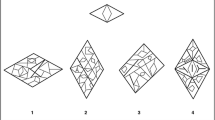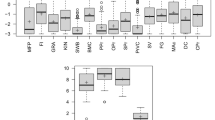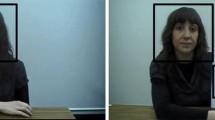Case reports and sensory inventories suggest that autism involves sensory processing anomalies. Behavioral tests indicate impaired motion and normal form perception in autism. The present study used first-person accounts to investigate perceptual anomalies and related subjective to psychophysical measures. Nine high-functioning children with autism and nine typically-developing children were given a questionnaire to assess the frequency of sensory anomalies, as well as psychophysical tests of visual perception. Results indicated that children with autism experience increased perceptual anomalies, deficits in trajectory discrimination consistent with dysfunction in the cortical dorsal pathway or in cerebellar midsagittal vermis, and high spatial frequency contrast impairments consistent with dysfunctional parvocellular processing. Subjective visual hypersensitivity was significantly related to greater deficits across vision tests.





Similar content being viewed by others
Notes
The revised instrument is available from the authors upon request.
REFERENCES
Belmonte M. K., Yurgelun-Todd D. A., (2003). Functional anatomy of impaired selective attention and compensatory processing in autismCognitive Brain Research 17, 651–664
Bookstein F., Sampson P. D., Streissguth A. P., Barr H. M., (1996). Exploiting redundant measurement of dose and developmental outcome: New methods from the behavioral teratology of alcoholDevelopmental Psychology, 32, 404–415
Brenner C. A., Wilt M. A., Lysaker P. H., O’Donnell B. F., (2003). Psychometrically matched tasks of discrimination and recognition performance in schizophrenia spectrum disordersJournal of Abnormal Psychology 112, 28–37
Bunney W. E., Jr., Hetrick W. P., Bunney B. G., Patterson J. V., Jin. Y., Jr., Potkin S. G., Sandman C. A., (1999). Structured interview for assessing perceptual anomalies (SIAPA)Schizophrenia Bulletin, 25, 577–592
Chapman L. J., Chapman J. P., (1978). The measurement of differential deficitJournal of Psychiatric Research 14, 303–311
Courchesne E., (1997). Brainstem, cerebellar and limbic neuroanatomical abnormalities in autismCurrent Opinion in Neurobiology 7: 269–278
Dupont P., Orban G. A., de Bruyn B., Verbruggen A., Mortelmans L., (1994). Many areas in the human brain respond to visual motionJournal of Neurophysiology, 72, 1420–1424
Farmer C. M., O’Donnell B. F., Niznikiewicz M. A., Voglmaier M. M., McCarley R. W., Shenton M. E., (2000). Visual perception and working memory in schizotypal personality disorderThe American Journal of Psychiatry 157, 781–786
Gillberg C., Coleman M., (2000). The Biology of Autistic Syndromes, 3rd Ed. Cambridge, UK: Cambridge University Press
Grandin, T. (2000). My experiences with visual thinking sensory problems and communication difficulties. http://www.autism.org/contents.html#temple
Grandin T., (1992). An inside view of autism. In: Schopler E., Mesibov G. B., (Eds.) High-functioning individuals with autism. New York, NY: Plenum Press. pp. 105–126
Haas R. H., Townsend, J., Courchesne E., Lincoln A. J., Schreibman L., Yeung-Courchesne R., (1996). Neurologic abnormalities in infantile autismJournal of Child Neurology 11, 84–92
Hautzel H., Taylor J. G., Krause B. J., Krause B. J., Schmitz N., Tellmann L., Ziemons K., Shah N. J., Herzog H., Muller-Gartner H. W., (2001). The motion aftereffect: More than area V5/MT? Evidence from 15O-butanol PET studiesBrain Research 892, 281–292
Kientz M. A., Dunn W., (1997). A comparison of the performance of children with and without autism on the sensory profileThe American Journal of Occupational Therapy 51, 530–537
Levitt H., (1970). Transformed up-down methods in psychoacousticsThe Journal of the Acoustical Society of America 49, 467–477
Livingstone M. S., Hubel D. H., (1988). Segregation of form, color, movement, and depth: Anatomy, physiology, and perceptionScience 240, 740–749
Lord C., Rutter M., Le Couteur A., (1994). Autism diagnostic interview-revised, a revised version of a diagnostic interview for caregivers of individuals with possible pervasive developmental disordersJournal of Autism and Developmental Disorders 24, 659–685
Merigan W. H., Byrne C. E., Maunsell J. H. R., (1991a). Does primate motion perception depend on the magnocellular pathway?The Journal of Neuroscience 11, 3422–3429
Merigan W. H., Katz L. M., Maunsell J. H. R., (1991b). The effects of parvocellular lateral geniculate lesions on the acuity and contrast sensitivity of macaque monkeysThe Journal of Neuroscience 11, 994–1001
Merigan W. H., Maunsell J. H. R., (1990). Macaque vision after magnocellular lateral geniculate lesionsVisual Neuroscience 5, 347–352
Merigan W. H., Maunsell J. H. R., (1993). How parallel are the primate visual pathways?Annual Review of Neuroscience 16, 369–402
Milne E., Swettenham J., Hansen P., Campbell R., Jeffries H., Plaisted K., (2002). High motion coherence thresholds in children with autismJournal of Child Psychology, Psychiatry and Allied Disciplines 32, 255–263
Mottron L., Belleville S., Menard E., (1999). Local bias in autistic subjects as evidenced by graphic tasks: Perceptual hierarchization or working memory deficit?Journal of Child Psychology, Psychiatry and Allied Disciplines 40, 743–755
Muller R.A., Kleinhans N., Kemmotsu N., Pierce K., Courchesne E., (2003). Abnormal variability and distribution of functional maps in autism: An FMRI study of visuomotor learningAmerican Journal of Psychiatry 160, 1847–1862
Nawrot M., Rizzo M., (1998). Chronic motion perception deficits from midline cerebellar lesions in humanVision Research 38, 2219–2224
Newsome W. T., Pare E. B., (1988). A selective impairment of motion perception following lesions of the middle temporal visual area (MT)The Journal of Neuroscience 8, 2201–2211
O’Donnell B. F., McCarley R. W., Potts G. F., Salisbury D. F., Nestor P. G., Hirayasu Y., Niznikiewicz M. A., Barnard J., Shen Z. J., Weinstein D. W., Bookstein F., Shenton M. E., (1999). Identification of neural circuits underlying P300 abnormalities in schizophrenia. Psychophysiology 36, 388–398
O’Riordan M., Plaisted K., (2001). Enhanced discrimination in autismThe Quarterly Journal of Experimental Psychology 54a, 961–979
Ornitz E. M., Guthrie D., Farley A. H., (1977). The early development of autistic childrenJournal of Autism and Childhood Schizophrenia 7, 207–229
Pierce K., Courchesne E., (2001). Evidence for a cerebellar role in reduced exploration and stereotyped behavior in autismBiological Psychiatry 49, 655–664
Shadlen M. N., Newsome W. T., (2001). Neural basis of a perceptual decision in the parietal cortex (area LIP) of the rhesus monkeyJournal of Neurophysiology 86, 1916–1936
Skottun B. C., (2000). The magnocellular deficit theory of dyslexia: The evidence from contrast sensitivityVision Research, 40, 111–127
Spencer J., O’Brien J., Riggs K., Braddick O., Atkinson J., Wattam-Bell J., (2000). Motion processing in autism: Evidence for a dorsal stream deficiencyNeuroReport 11, 2765–2767
Stehli A., (1991). The sound of a miracle. New York, NY: Doubleday
Talay-Ongan A., Wood K., (2000). Unusual sensory sensitivities in autism: A possible crossroadsThe International Journal of Disability, Development and Education 47, 201–212
The Psychological Corporation (1991). The wechsler intelligence scale for children, third edition. San Antonio, TX
Townsend J., Harris N. S., Courchesne E., (1996). Visual attention abnormalities in autism: Delayed orienting to locationJournal of the International Neuropsychological Society 2, 541–550
Townsend J., Westerfield M., Leaver E., Makeig S., Jung T., Pierce K., Courchesne E., (2001). Event-related brain response abnormalities in autism: Evidence for impaired cerebello-frontal spatial attention networksCognitive Brain Research 11, 127–45
Tyler C., (1991). Analysis of normal flicker sensitivity and its variability in the visuogram testInvestigative Opthalmology and Visual Science 32, 2552–2560
Tyler C., (1995). The morphonome image psychophysics software and calibrator for macintosh systems, 3.5.2.1 ed. San Francisco, CA: The Smith-Kettlewell Eye Institute
Ungerleider L. G., Mishkin M., (1982). Two cortical visual systems, analysis of visual behavior. Cambridge, MA: MIT Press. pp. 549–586
Williams D., (1994). Nobody nowhere. New York, NY: Avon Books
ACKNOWLEDGMENTS
This research was supported by a National Defense Science and Engineering Graduate Fellowship, NIMH grants (RO1 MH62150-01; RO3 MH63112-01) awarded to Brian F. O’Donnell, the Indiana University Cognitive Science Program for Marcia B. Bockbrader, and the Indiana University Honors College for Rebecca A.O. Davis. We thank all the mothers and children who volunteered their time and their participation. We are grateful to Evan Davis for technical assistance regarding the psychophysical paradigms and P. Poskozim and W. Clevenger for assistance in testing participants. We acknowledge K. O’Bryan for her inspiration and guidance and E. Davis and E. Wilt for their continued support.
Author information
Authors and Affiliations
Corresponding author
Additional information
A poster presentation of this study was presented at the conference of the Society of Biological Psychiatry, March 2002, in Philadelphia, Pennsylvania, USA.
Rights and permissions
About this article
Cite this article
Davis, R.A.O., Bockbrader, M.A., Murphy, R.R. et al. Subjective Perceptual Distortions and Visual Dysfunction in Children with Autism. J Autism Dev Disord 36, 199–210 (2006). https://doi.org/10.1007/s10803-005-0055-0
Published:
Issue Date:
DOI: https://doi.org/10.1007/s10803-005-0055-0




